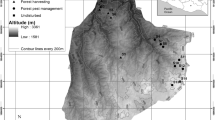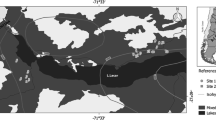Abstract
Context
Recruitment is an important process in forest stand dynamics, especially in uneven-aged stands. Continuous recruitment is a prerequisite for diverse, uneven-aged silvicultural systems, but patterns may vary significantly.
Aims
The main goals of the study were to examine the recruitment of the main tree species in selection and irregular shelterwood stands in silver fir–European beech–Norway spruce forests and to determine the main predictors of the recruitment occurrence.
Methods
Data from 5,486 permanent inventory plots were used to study recruitment of saplings into the tree layer (diameter at breast height ≥10 cm).
Results
Recruitment rate differed significantly between selection (7.6 trees ha−1 year−1) and irregular shelterwood (26.1 trees ha−1 year−1) stands. Shade-tolerant fir and beech recruited with higher probability in selection stands, while light-dependent sycamore recruited with higher probability in irregular stands. In addition, forest types, soil pH, stand basal area, mean diameter, and the basal area of the same tree species with respect to recruitment were found to be important predictors of recruitment occurrence.
Conclusions
The application of different uneven-aged silvicultural systems and their forms makes it possible to considerably influence the future tree species composition of uneven-aged forests.



Similar content being viewed by others
References
Allison PD (1999) Logistic regression using SAS system: theory and application. SAS Institute Inc, Cary
Boncina A (2011) History, current status and future prospects of uneven-aged forest management in the Dinaric region: an overview. Forestry 84:467–478. doi:10.1093/forestry/cpr023
Brassel P, Lischke H (2001) Swiss National Forest Inventory: methods and models of the second assessment. WSL Swiss Federal Research Institute, Birmensdorf, Switzerland
Cameron AD, Hands MOR (2010) Developing a sustainable irregular structure: an evaluation of three inventories at 6-year intervals in an irregular mixed-species stand in Scotland. Forestry 83:469–475. doi:10.1093/forestry/cpq029
Collet C, Lanter O, Pardos M (2001) Effects of canopy opening on height and diameter growth in naturally regenerated beech seedlings. Ann For Sci 58:127–134
Diaci J (2006) Gojenje gozdov: pragozdovi, sestoji, zvrsti, nacrtovanje, izbrana poglavja (in Slovene). Biotechnical faculty. Department for Forestry and Renewable Forest Resources, Ljubljana, Slovenia
Duc P (1991) Untersuchungen zur Dynamik des Nachwuchses im Plenterwald. Schweiz Z Forstwes 142:299–319
Ferlin F (2002) The growth potential of understorey silver fir and Norway spruce for uneven-aged forest management in Slovenia. Forestry 75:375–383. doi:10.1093/forestry/75.4.375
Ficko A, Poljanec A, Boncina A (2011) Do changes in spatial distribution, structure and abundance of silver fir (Abies alba Mill.) indicate its decline? For Ecol Manage 261:844–854. doi:10.1016/j.foreco.2010.12.014
Gill RMA (1992) A review of damage by mammals in north temperate forests. 3. Impact on trees and forests. Forestry 65:363–388. doi:10.1093/forestry/65.4.363-a
Guisan A, Zimmermann N (2000) Predictive habitat distribution models in ecology. Ecol Model 135:147–186. doi:10.1016/S0304-3800(00)00354-9
Jerina K (2012) Roads and supplemental feeding affect home-range size of Slovenian red deer more than natural factors. J Mammal (in press)
Klopcic M, Jerina K, Boncina A (2010) Long-term changes of structure and tree species composition in Dinaric uneven-aged forests: are red deer an important factor? Eur J For Res 129:277–288. doi:10.1007/s10342-009-0325-z
Kneeshaw DD, Prevost M (2007) Natural canopy gap disturbances and their role in maintaining mixed-species forests of central Quebec, Canada. Can J For Res 37:1534–1544. doi:10.1139/x07-112
Lähde E, Laiho O, Norokorpi Y, Saksa T (2002) Development of Norway spruce dominated stands after single-tree selection and low thinning. Can J For Res 32:1577–1584. doi:10.1139/x02-075
Leinbundgut H (1952) Rolle und Grundlagen der Planung beim schweizerischen Femelschlag- und Plenterbetrieb. Allg Forst- und Jagdzeitung 123:93–100
Lexerød N (2005) Recruitment models for different tree species in Norway. For Ecol Manage 206:91–108. doi:10.1016/j.foreco.2004.11.001
Lexerød N, Eid T (2005) Recruitment models for Norway spruce, Scots pine, birch and other broadleaves in young growth forests in Norway. Silva Fenn 39:391–406
Lundqvist L (2004) Stand development in uneven-aged sub-alpine Picea abies stands after partial harvest estimated from repeated surveys. Forestry 77:119–129. doi:10.1093/forestry/77.2.119
Malcolm DC, Mason WL, Clarke GC (2001) The transformation of conifer forests in Britain—regeneration, gap size and silvicultural systems. For Ecol Manage 151:7–23. doi:10.1016/S0378-1127(00)00692-7
Mathews JD (1999) Silvicultural systems. Oxford University Press Inc, New York
Motta R (1996) Impact of wild ungulates on forest regeneration and tree composition of mountain forests in the Western Italian Alps. For Ecol Manage 88:93–98. doi:10.1016/S0378-1127(96)03814-5
Nagel T, Svoboda M, Rugani T, Diaci J (2010) Gap regeneration and replacement patterns in an old-growth Fagus–Abies forest of Bosnia–Herzegovina. Plant Ecol 208:307–318. doi:10.1007/s11258-009-9707-z
Oliver CD, Larsen BC (1996) Forest stand dynamics. Wiley, New York
Petritan AM, von Lüpke B, Petritan IC (2007) Effects of shade on growth and mortality of maple (Acer pseudoplatanus), ash (Fraxinus excelsior) and beech (Fagus sylvatica) saplings. Forestry 80:397–412. doi:10.1093/forestry/cpm030
Raymond P, Bedard S, Roy V, Larouche C, Tremblay S (2009) The irregular shelterwood system: review, classification, and potential application to forests affected by partial disturbances. J For 107:405–413
Rozenbergar D, Mikac S, Anic I, Diaci J (2007) Gap regeneration patterns in relationship to light heterogeneity in two old-growth beech-fir forest reserves in South East Europe. Forestry 80:431–443. doi:10.1093/forestry/cpm037
Schäffer A, Gazin A, d’Alverny A (1930) Sapinieres: Le jardinage par contenance (Methode du controle par les courbes). Presses Universitaire de France, Paris
Schütz JP (1975) Dynamique et conditions d’équilibre de peuplements jardinés sur les stations de la hêtraie à sapin. Schweiz Z Forstwes 126:637–671
Schütz JP (2001) Der Plenterwald und weitere Formen strukturierter und gemischter Wälder. Parey, Berlin, Germany
Schütz JP (2006) Modelling the demographic sustainability of pure beech plenter forests in Eastern Germany. Ann For Sci 63:93–100. doi:10.1007/s10342-006-0111-0
SFS (2010) Databases on forest stand characteristics and permanent sampling plots. Slovenia Forest Service, Ljubljana, Slovenia
Stancioiu PT, O’Hara KL (2006) Regeneration growth in different light environments of mixed species, multiaged, mountainous forests of Romania. Eur J For Res 125:151–162. doi:10.1007/s10342-005-0069-3
Tjoelker MG, Boratiński A, Bugała W (2007) Biology and ecology of Norway spruce. Springer, Dordrecht
Yoshida T, Noguchi M, Akibayashi Y, Noda M, Kadomatsu M, Sasa K (2006) Twenty years of community dynamics in a mixed conifer—broad-leaved forest under a selection system in northern Japan. Can J For Res 36:1363–1375. doi:10.1139/x06-041
Acknowledgments
The authors would like to thank Slovenian Forest Service, especially Dragan Matijasic and Ales Poljanec, for providing the access to forest inventory data, which made our study feasible. The comments of the three anonymous reviewers significantly improved the earlier version of the manuscript.
Funding
The study was supported in part by a grant from Pahernikova ustanova (contract number 11/2011).
Author information
Authors and Affiliations
Corresponding author
Additional information
Handling Editor: Douglass Jacobs
Contributions of the co-authors
The first author’s contribution to the paper was in preparing the data, runing the data analysis, processing results, and writing the paper.
The last author’s contribution was in producing the research idea, coordinating and supervising the work, and editing the final version of the paper.
Rights and permissions
About this article
Cite this article
Klopcic, M., Boncina, A. Recruitment of tree species in mixed selection and irregular shelterwood forest stands. Annals of Forest Science 69, 915–925 (2012). https://doi.org/10.1007/s13595-012-0224-1
Received:
Accepted:
Published:
Issue Date:
DOI: https://doi.org/10.1007/s13595-012-0224-1




